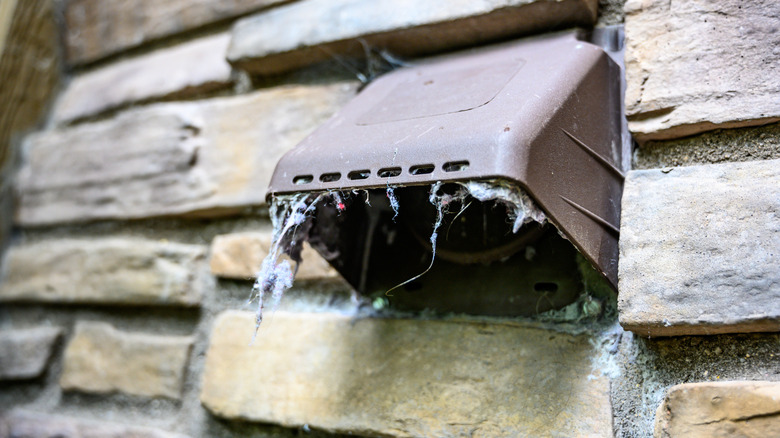The Method You Should Try To Prevent Dryer Vent Clogs While Keeping Animals Out
We may receive a commission on purchases made from links.
According to the National Fire Protection Agency, thousands of house fires in the U.S. each year are caused by dust, fibers, and lint from laundry dryers. Clogged filters and vents trap hot air, and the excess lint becomes kindling just waiting to ignite. Keeping the lint filter and dryer vent clean and clear is essential to keeping your home safe — not to mention preventing damage to your dryer – but exterior dryer vents can also pose another problem: critter access. Without the right mesh covering, mice and other pests could end up in your dryer vent.
Options abound for exterior dryer vent covers, also known as dryer vent hoods or caps, which are designed to keep animals out while allowing hot air to escape. However, most have a significant design flaw: their mesh covers exacerbate vent blockages. There are plenty of clever hacks for cleaning out your dryer lint trap, but what can you do to prevent lint from clogging the mesh of your exterior vent? If you want to prevent dryer vent clogs but you're also worried about keeping pests out, a dryer exhaust cage is a good alternative. The idea is to move the critter protection beyond the opening of the exhaust so it won't obstruct and clog the vent. It might not be the most attractive option, but for the sake of keeping your home fire-safe, energy-efficient, and pest-free, this is certainly a worthwhile hack.
How to build your own dryer vent cage
Professional dryer vent cleaners offer an example of a mesh cage for a rooftop dryer vent. As Spiegel Solutions shared on YouTube, they shaped their cage to completely cover the vent while leaving about 5 inches of space all the way around. Of course, the cage still needs to have an opening in order to access the vent for cleaning, but it can be secured closed with zip ties to keep animals out. If you aren't keen on constructing your own, products like the HY-GUARD Stainless Steel Universal Vent Guard can offer a quick way to cover your vents, but will need to be unscrewed and removed for routine cleanings.
Of course, you need to evaluate the animals you are trying to deter to determine the proper cage material and size of the mesh openings to implement this hack. In the case of Spiegel Solution's client, the cage constructed was used specifically to keep large iguanas out of the vent. If you deal with mice, rats, squirrels, or birds, galvanized steel mesh may be a better option, and you can find mesh with openings as small as ¼ inches. If you deal with bees, wasps, or other insects getting in your vent, consider lining the cage with an insect netting. The key is to secure your cage walls far enough away from the vent so it can operate free of obstruction. While the open cage style can prevent lint from building up so quickly, you'll still need to watch for surefire signs it's time to clean your dryer vent.
